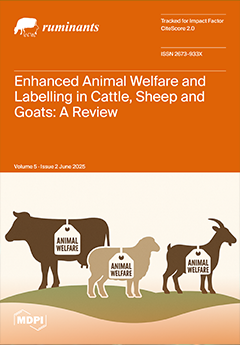Cytokine and Anti-Müllerian Hormone (AMH) profiling were performed in prepubertal Murrah buffalo heifers’ post-progesterone supplementation and Co-synchronization (Co-synch) protocol. Cytokine (IFNγ, IL6, IL1, IL13, TNFα, and TGFβ), AMH, progesterone, and estrogen hormone estimations were conducted. The ovarian follicular pattern and fertility outcome were
[...] Read more.
Cytokine and Anti-Müllerian Hormone (AMH) profiling were performed in prepubertal Murrah buffalo heifers’ post-progesterone supplementation and Co-synchronization (Co-synch) protocol. Cytokine (IFNγ, IL6, IL1, IL13, TNFα, and TGFβ), AMH, progesterone, and estrogen hormone estimations were conducted. The ovarian follicular pattern and fertility outcome were recorded. Eighteen prepubertal heifers, 15–17 months of age, 250–300 kg body weight (BWt) were randomly divided into three groups, Group 1:
n = 6, supplemented with altrenogest 0.044 mg/kg BWt/day/heifer orally for 14 days along with Co-synch program; Group 2:
n = 6, implanted Controlled Internal Drug Release (CIDR) for 14 days and co-synch program, Group 3:
n = 6, received Co-synch program. Ultrasonography was performed to determine ovarian follicle status on respective days of sampling. Pregnancy diagnosis was performed around 45 and 60 days post artificial insemination (AI). The Estradiol 17-β level remained constant in Group 1, Group 2, and Group 3 during the progesterone treatment and Co-synch treatment. Estradiol levels during Co-synch were significantly less (
p = 0.024) on day 9 of Co-synch (14.41 ± 1.97 pg/mL) than on day 0 (20.11 ± 0.36 pg/mL) and on day 7 (19.77 ± 0.34 pg/mL) in prepubertal buffalo heifers in Group 1. However, no significance was observed in other groups. Progesterone levels in buffalo heifers subjected to synchronization protocols varied significantly (
p < 0.05) on day 7 of progesterone (P4) treatment between Group 1, Group 2, and Group 3. Supplementation of altrenogest showed a significant (
p = 0.043) increase in progesterone levels by day 14 of altrenogest treatment. Progesterone varied significantly in all groups on day 9 of Co-synch protocol [Group 1 (
p = 0.020), Group 2 (
p = 0.041), and Group 3 (
p = 0.007)]. Cytokine IFNγ showed high correlation with progesterone, indicating the role of IFNγ in puberty in buffalo heifers (r = 0.626,
p < 0.01). Anti-Müllerian Hormone had a significant positive correlation when supplemented with altrenogest with IFNγ (r = 0.673,
p < 0.01) and TGFβ (r = 0.463,
p < 0.01), whereas it was a negatively correlated with TNFα (r = −0.34,
p < 0.05). Based on Karl Pearson correlation coefficients, IL13 and TGFβ could be considered as markers for puberty in buffalo heifers.
Full article





